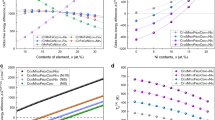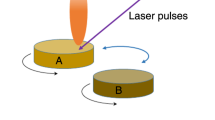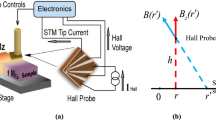Abstract
Exploration of new ferroic (ferroelectric, ferromagnetic or ferroelastic) materials continues to be a central theme in condensed matter physics and to drive advances in key areas of technology. Here, using thin-film composition spreads, we have mapped the functional phase diagram of the Ni–Mn–Ga system whose Heusler composition Ni2MnGa is a well known ferromagnetic shape-memory alloy. A characterization technique that allows detection of martensitic transitions by visual inspection was combined with quantitative magnetization mapping using scanning SQUID (superconducting quantum interference device) microscopy. We find that a large, previously unexplored region outside the Heusler composition contains reversible martensites that are also ferromagnetic. A clear relationship between magnetization and the martensitic transition temperature is observed, revealing a strong thermodynamical coupling between magnetism and martensitic instability across a large fraction of the phase diagram.
This is a preview of subscription content, access via your institution
Access options
Subscribe to this journal
Receive 12 print issues and online access
$259.00 per year
only $21.58 per issue
Buy this article
- Purchase on Springer Link
- Instant access to full article PDF
Prices may be subject to local taxes which are calculated during checkout




Similar content being viewed by others
References
Hill, N.A. & Filippetto, A. Why are there any magnetic ferroelectrics? J. Magn. Magn. Mater. 242, 976–979 (2002).
James, R.D. & Wuttig, M. Magnetostriction of martensite. Phil. Mag. A 77, 1273–1299 (1998).
Sozinov, A., Likhachev, A.A., Lanska, N. & Ullakko, K. Giant magnetic-field-induced strain in NiMnGa seven-layered martensitic phase. Appl. Phys. Lett. 80, 1746–1748 (2002).
Xiang, X.D. et al. A combinatorial approach to materials discovery. Science 268, 1738–1740 (1995).
Wang, J. et al. Identification of a blue photoluminescent composite material from a combinatorial library. Science 279, 1712–1714 (1998).
van Dover, R.B., Schneemeyer, L.F. & Fleming, R.M. Discovery of a useful thin-film dielectric using a composition-spread approach. Nature 392, 162–164 (1998).
Yoo, Y.K. et al. Continuous mapping of structure-property relations in Fe1−xNix metallic alloys fabricated by combinatorial synthesis. Intermetallics 9, 541–545 (2001).
Fleet, E.F., Chatraphorn, S., Wellstood, F.C., Knauss, L.A. & Green, S.M. Closed-cycle refrigerator-cooled scanning SQUID microscope for room-temperature samples. Rev. Sci. Instrum. 72, 3281–3290 (2001).
Fleet, E.F. Design and Applications of a Cryo-cooled Scanning SQUID Microscope. Thesis, Univ. Maryland (2000).
Murray, S.J. et al. Large field induced strain in single crystalline Ni–Mn–Ga ferromagnetic shape memory alloy. J. Appl. Phys. 87, 5774–5776 (2000).
Murray, S.J., Marioni, M., Tello, P.G., Allen, S.M. & O'Handley, R.C. Giant magnetic-field-induced strain in Ni–Mn–Ga crystals: experimental results and modeling. J. Magn. Magn. Mater. 242, 945–947 (2001).
Chernenko, V.A., Cesari, E., Kokorin, V.V. & Vitenko, I.N. The development of new ferromagnetic shape memory alloys in Ni–Mn–Ga system. Scripta Metall. Mater. 33, 1239–1244 (1995).
Vasil'ev, A.N. et al. Structural and magnetic phase transition in shape-memory alloys Ni2+xMn1−xGa. Phys. Rev. B 59, 1113–1120 (1999).
Patil, S.I. et al. Ferromagnetic resonance in Ni–Mn–Ga films. Appl. Phys. Lett. 81, 1279–1281 (2002).
Wuttig, M., Craciunescu, C. & Li, J. Phase transformations in ferromagnetic NiMnGa shape memory films. Mater. Trans. JIM 41, 933–937 (2000).
Ahlers, M. Phase stability of martensitic structures. J.Phys. IV 5, 71–80 (1995).
Miyazaki, S. & Ishida, A. Martensitic transformation and shape memory behavior in sputter-deposited TiNi-base thin films. Mater. Sci. Eng. A 273, 106–133 (1999).
Craciunescu, C.M., Li, J. & Wuttig, M. Thermoelastic stress-induced thin film martensites. Scripta Mater. 48, 65–70 (2003).
Wuttig, M., Liu, L., Tsuchiya, K. & James, R.D. Occurrence of ferromagnetic shape memory alloys. J. Appl. Phys. 87, 4707–4711 (2000).
Chernenko, V.A. Compositional instability of β-phase in Ni–Mn–Ga alloys. Scripta Mater. 40, 523–527 (1999).
Bozorth, R.M. Ferromagnetism 317 (IEEE Press, New Jersey, 1993).
Wijn, H.P.J. (ed.) Data in Science and Technology 54 (Springer, Berlin-Heidelberg, 1991).
Wassermann, E.F., Kastner, J., Acet, M. & Entel, P. Electronic origin of the martensitic transitions in Fe-based systems and Hume–Rothery systems: a comparison. Proc. Int. Conf. Solid-State Phase Transitions '99 (JIMIC-3) 807–814 (1999).
Zayak, A.T., Buchelnikov, V.D. & Entel, P. A Ginzburg–Landau theory for Ni–Mn–Ga. Phase Transit. 75, 243–256 (2002).
Zener, C. in Elasticity and Anelasticity of Metals 37 (Univ. Chicago Press, Chicago, 1948).
Godlevsky, V.V. & Rabe, K.M. Soft tetragonal distortions in ferromagnetic Ni2MnGa and related materials from first principles. Phys. Rev. B 63, 134407–1–5 (2001).
Pickett, W.E. & Moodera, J.S. Half metallic magnets. Phys. Today 54, 39–44 (2001).
Acknowledgements
This project was funded by ONR N000140010503 and N000140110761, NSF DMR0076456 and DMR0114176, and the New Jersey Commission on Higher Education.
Author information
Authors and Affiliations
Corresponding author
Ethics declarations
Competing interests
The authors declare no competing financial interests.
Supplementary information
41563_2003_BFnmat829_MOESM1_ESM.mov
Movie 1Detection of structural transition by visual inspection is demonstrated in this movie, which shows a close up view of a row of cantilevers with a spread deposited. The movie tracks the temperature change from 150 K to 570 K. Every frame is taken with a 5 K increment. All cantilevers are seen to 'relax' as temperature increases due to thermal expansion, and coloured lines in the reflected image move downward. At slightly different temperatures, cantilevers in the middle of the row undergo contraction due to transformation to austenites, and the lines move upward at the transitions. (MOV 552 kb)
Rights and permissions
About this article
Cite this article
Takeuchi, I., Famodu, O., Read, J. et al. Identification of novel compositions of ferromagnetic shape-memory alloys using composition spreads. Nature Mater 2, 180–184 (2003). https://doi.org/10.1038/nmat829
Received:
Accepted:
Published:
Issue Date:
DOI: https://doi.org/10.1038/nmat829
This article is cited by
-
Machine learning autonomous identification of magnetic alloys beyond the Slater-Pauling limit
Communications Materials (2021)
-
High-throughput characterization of the adiabatic temperature change for magnetocaloric materials
Journal of Materials Science (2021)
-
High-entropy ceramics
Nature Reviews Materials (2020)
-
Effect on Annealing Temperature (Ta) of Ternary Full Fe2CrSi Heusler Alloy Nanoparticles for Spin-Based Device Applications
Journal of Superconductivity and Novel Magnetism (2020)
-
Machine-learning guided discovery of a new thermoelectric material
Scientific Reports (2019)



